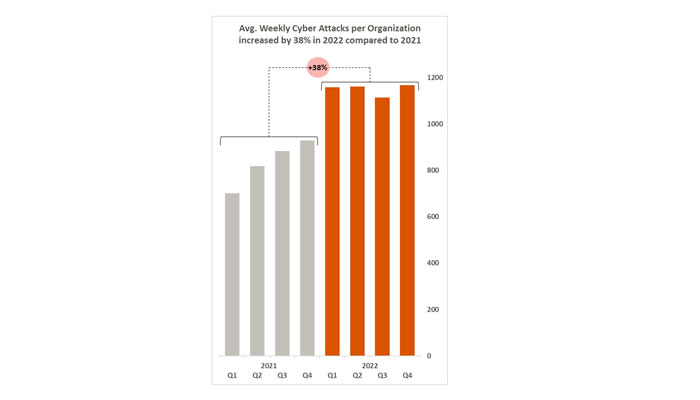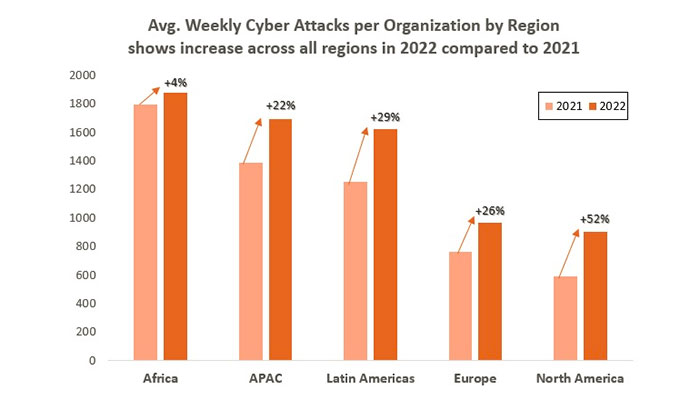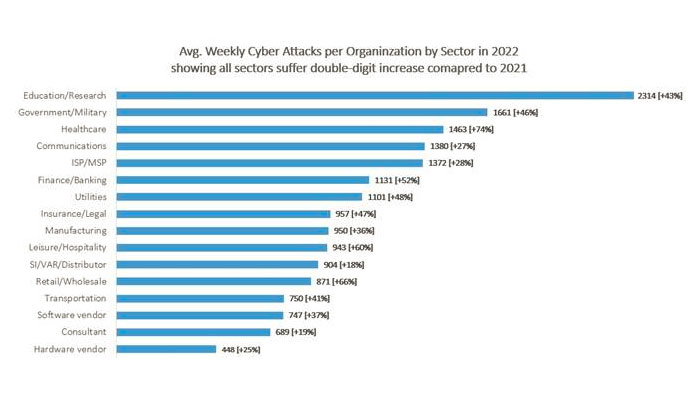Check Point Research (CPR) released new data on 2022 cyberattack trends. The data is segmented by global volume, industry and geography. Global cyberattacks increased by 38% in 2022, compared to 2021. These cyberattack numbers were driven by smaller, more agile hacker and ransomware gangs, who focused on exploiting collaboration tools used in work-from-home environments, targeting of education institutions that shifted to e-learning post COVID-19. This increase in global cyberattacks also stems from hacker interest in healthcare organizations, which saw the largest increase in cyberattacks in 2022, when compared to all other industries. CPR warns that the maturity of AI technology, such as CHATGPT, can accelerate the number of cyberattacks in 2023. Check Point Research (CPR) has released new data on last year’s cyberattack trends. The data is segmented by global volume, industries, continents and countries.

Key Statistics:
- Global volume of cyberattacks reached an all-time high in Q4 with an average of 1168 weekly attacks per organization
- Top 3 most attacked industries in 2022 were Education/Research, Government and Healthcare
- Geography of Africa experienced the highest volume of attacks with 1875 weekly attacks per organization, followed by APAC with 1691 weekly attacks per organization
- North America (+52%), Latin America (+29%) and Europe (+26%) showed largest increases in cyberattacks in 2022, compared to 2021
- USA saw a 57% increase in overall cyberattacks in 2022, UK saw a 77% increase and Singapore saw a 26% increase

Omer Dembinsky, Data Group Manager at Check Point Software, said, “Cyberattacks are increasing world-wide, with 38% more cyberattacks per week on corporate networks in 2022, compared to 2021. Several cyber threat trends are all happening at once. For one, the ransomware ecosystem is continuing to evolve and grow with smaller, more agile criminal groups that form to evade law enforcement. Second, hackers are widening their aim to target business collaboration tools such as Slack, Teams, OneDrive and Google Drive with phishing exploits. These make for a rich source of sensitive data given that most organizations’ employees continue to work remotely. Third, academic institutions have become a popular feeding ground for cybercriminals following the rapid digitization they undertook in response to the COVID-19 pandemic. In fact, the education/research sector was the number one most attacked industry globally, seeing a 43% increase in 2022 compared to 2021, with an average of 2,314 attacks per organization every week. Many education institutions have been ill-prepared for the unexpected shift to online learning, creating ample opportunity for hackers to infiltrate networks through any means necessary. Schools and universities also have the unique challenge of dealing with children or young adults, many of which use their own devices, work from shared locations, and often connect to public WiFi without thinking of the security implications.

Looking back at cyberattacks for the healthcare sector in 2022, healthcare organizations in the US suffered an average of 1410 weekly cyberattacks per organization, which is 86% higher than the number we saw in 2021, with the healthcare sector ranking second out of all sectors for the most cyberattacks in the US. Hackers like to target hospitals because they perceive them as short on cyber security resources with smaller hospitals particularly vulnerable, as they are underfunded and understaffed to handle a sophisticated cyberattack. The healthcare sector is so lucrative to hackers as they aim to retrieve health insurance information, medical records numbers and, sometimes, even social security numbers with direct threats from ransomware gangs to patients, demanding payment under threats of having patient records released. Ransomware gangs also find the attention gained from attacking a hospital as an attractive plus-point for their notoriety. Unfortunately, we expect the increase in cyberattack activity to only increase. With AI technologies such as ChatGPT readily available to the public, it is possible for hackers to generate malicious code and emails at a faster, more automated pace. To protect yourself, it is imperative to think about prevention first, not detection. There are several best practices and actions an organization can take to minimize their exposure to the next attack or breach, such as cyber security training, keeping patches up-to-date and implementing anti-ransomware technology.”




